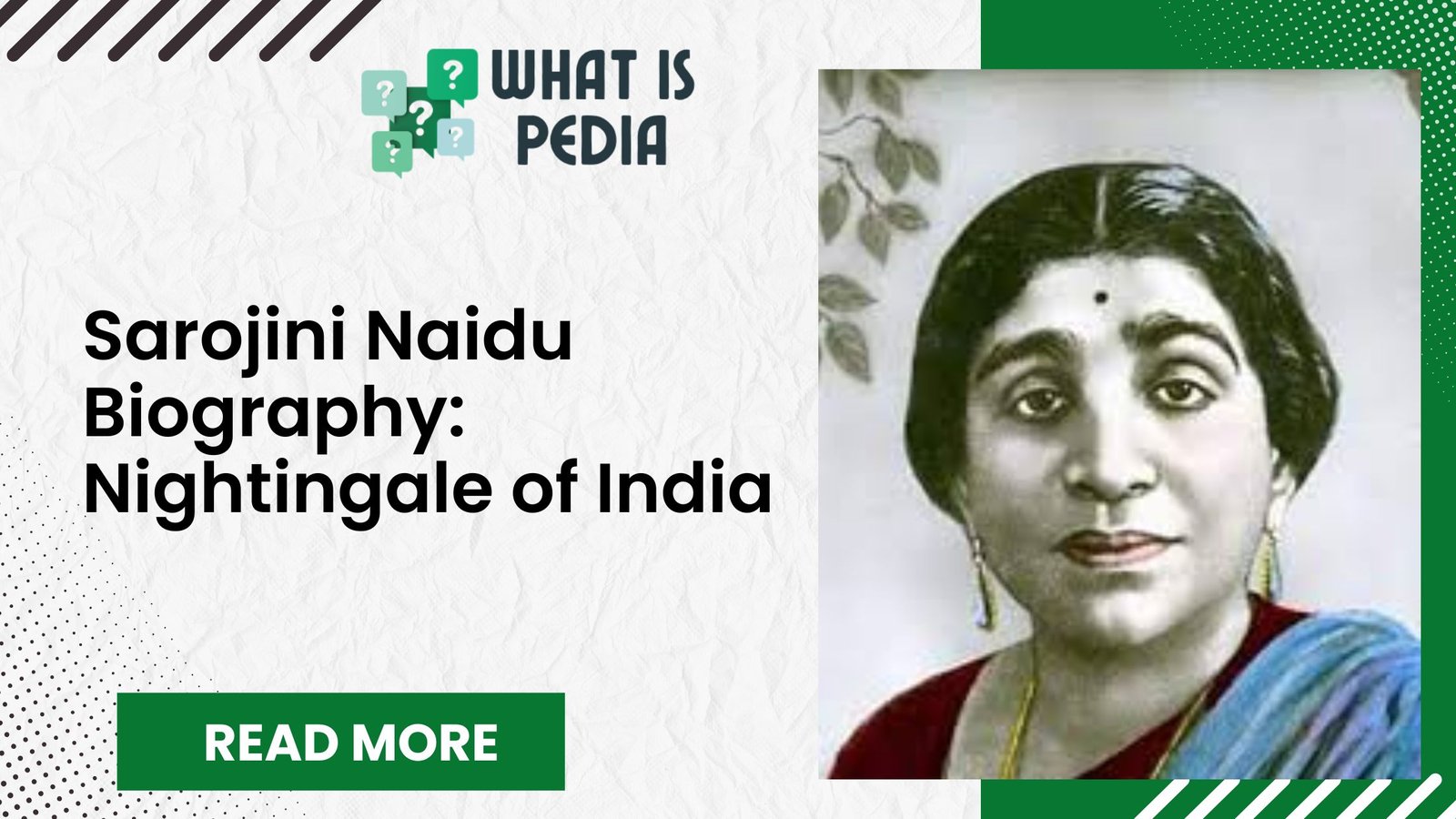1. Introduction
Sarojini Naidu, famously known as the Nightingale of India, was a prominent poet, freedom fighter, and political leader. Born as Sarojini Chattopadhyay, she was a trailblazer who used her literary prowess and oratory skills to inspire millions during the Indian independence movement. Her life is a testament to the power of words and action, seamlessly blending poetry with patriotism.
As the first Indian woman to become the President of the Indian National Congress and the first woman Governor of an Indian state, Sarojini Naidu broke several barriers. Understanding her life offers insights into India’s struggle for freedom and the role women played in shaping the nation’s destiny.
2. Early Life and Family Background
Sarojini Naidu was born as Sarojini Chattopadhyay on February 13, 1879, in Hyderabad, India. She was the eldest daughter of Aghorenath Chattopadhyay, a renowned educationist and scientist, and Barada Sundari Devi, a Bengali poetess. Her upbringing in an intellectually stimulating environment significantly influenced her future pursuits.
Her father, Aghorenath Chattopadhyay, was the principal of Nizam’s College, Hyderabad, and an advocate for women’s education. Her mother, Barada Sundari Devi, wrote Bengali poetry, which inspired young Sarojini to explore the world of literature.
Sarojini Naidu had several siblings, including her brother Virendranath Chattopadhyay, a prominent revolutionary. The Chattopadhyay household was a hub of intellectual discussions and artistic pursuits, shaping Sarojini’s multifaceted personality.
3. Education and Early Literary Pursuits
Sarojini Naidu’s academic journey began in Hyderabad, where she displayed exceptional brilliance from an early age. She was a prodigy, mastering multiple languages, including English, Bengali, Urdu, and Telugu.
At the age of 12, she wrote her first play, “Maher Muneer”, which impressed the Nizam of Hyderabad. Recognizing her talent, the Nizam awarded her a scholarship to study abroad. She pursued higher education at King’s College, London, and later at Girton College, Cambridge.
During her time in England, she was exposed to Western literature and the rising wave of Indian nationalism. Her poetic style evolved, combining Western influences with Indian themes, making her an exceptional voice in Indian English literature.
4. Marriage and Personal Life
In 1898, Sarojini Chattopadhyay married Govindarajulu Naidu, a non-Brahmin doctor from Andhra Pradesh. Their inter-caste marriage was a bold step in pre-independence India, reflecting Sarojini’s progressive outlook.
The couple had four children, and Sarojini balanced her personal life with her literary and political commitments. Despite her busy schedule, she remained a devoted mother and wife, showing how women could balance multiple roles.
5. Rise as the ‘Nightingale of India’
Sarojini Naidu earned the title “Nightingale of India” from Mahatma Gandhi for her lyrical poetry and inspiring speeches. Her works beautifully captured the essence of Indian culture, nature, love, and patriotism.
Major Poetry Collections:
- “The Golden Threshold” (1905): Her first collection, reflecting themes of love, nature, and nationalism.
- “The Bird of Time” (1912): Emphasized the passage of time and the fleeting nature of life.
- “The Broken Wing” (1917): Featured the iconic poem “Awake, Arise!”, urging Indians to fight for freedom.
Sarojini Naidu’s poetry stood out for its musical quality, rich imagery, and deep emotional resonance. She drew inspiration from Indian folklore, traditions, and societal issues, making her work both relatable and inspiring.
6. Role in India’s Freedom Movement
While Sarojini Naidu gained fame as a poet, her passion for India’s freedom drew her into politics. Inspired by Gopal Krishna Gokhale and Mahatma Gandhi, she became an active participant in the independence movement.
Key Contributions:
- Swadeshi Movement: Promoted the use of Indian goods and boycotting British products.
- Civil Disobedience Movement: Participated in protests and was imprisoned multiple times.
- Salt March (1930): Joined Gandhi’s famous Dandi March and faced imprisonment.
- Quit India Movement (1942): Played a crucial role in mobilizing women and youth.
Her powerful speeches and writings advocated for women’s rights, nationalism, and social reforms, making her a respected leader.
7. Political Achievements and Leadership
Sarojini Naidu achieved several political milestones, breaking gender barriers in Indian politics:
- First Indian Woman President of the Indian National Congress (1925): She presided over the Kanpur session, highlighting the need for women’s participation in politics.
- First Woman Governor of an Indian State (1947): Appointed as the Governor of United Provinces (now Uttar Pradesh).
- Round Table Conferences (1930–1932): Represented Indian interests in London, advocating for self-rule.
Throughout her political career, Sarojini Naidu championed causes like women’s education, social reforms, and political empowerment.
8. Legacy and Death
Sarojini Naidu passed away on March 2, 1949, in Lucknow, while serving as the Governor of Uttar Pradesh. Her death marked the end of an era, but her legacy lives on.
Legacy:
- Her poems are part of educational curricula worldwide.
- Several institutions and awards are named after her.
- She inspired generations of poets, writers, and activists.
Sarojini Naidu remains a symbol of women’s empowerment, patriotism, and artistic excellence.
9. Conclusion
Sarojini Naidu’s life was a remarkable blend of art and activism. As the Nightingale of India, she used her words to inspire, educate, and mobilize people. Her contributions to India’s freedom movement and women’s rights continue to inspire generations.
Her legacy reminds us of the power of resilience, intellect, and creativity in shaping a better world.
To learn about another fearless Indian icon, read our detailed blog on Lakshmi Bai: Fearless Queen of Jhansi.
10. FAQs Section
Q1: Who was Sarojini Naidu, and why is she called the Nightingale of India?
A: Sarojini Naidu was an Indian poet, freedom fighter, and political leader. She was called the Nightingale of India because of her lyrical poetry and melodious style of writing.
Q2: What were Sarojini Naidu’s major contributions to Indian politics?
A: She actively participated in the Swadeshi Movement, Civil Disobedience Movement, and Quit India Movement. She was also the first Indian woman to preside over the Indian National Congress.
Q3: What are some famous poems written by Sarojini Chattopadhyay?
A: Some of her famous works include “The Golden Threshold”, “The Bird of Time”, and “The Broken Wing”.
Q4: When and how did Sarojini Naidu die?
A: Sarojini Naidu passed away on March 2, 1949, in Lucknow, while serving as the Governor of Uttar Pradesh.







